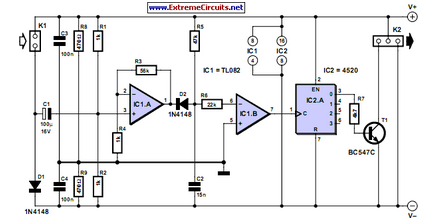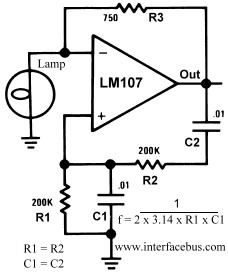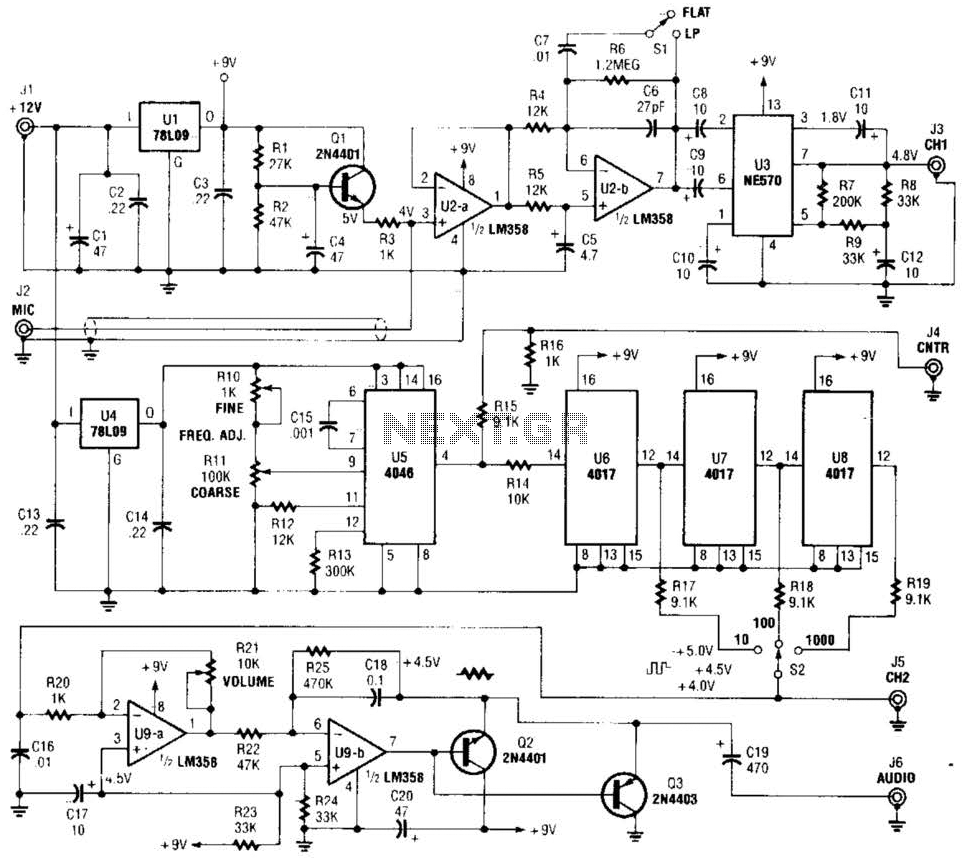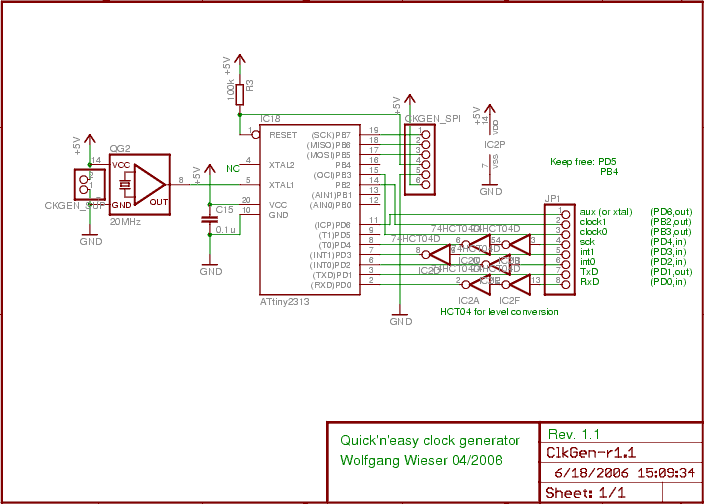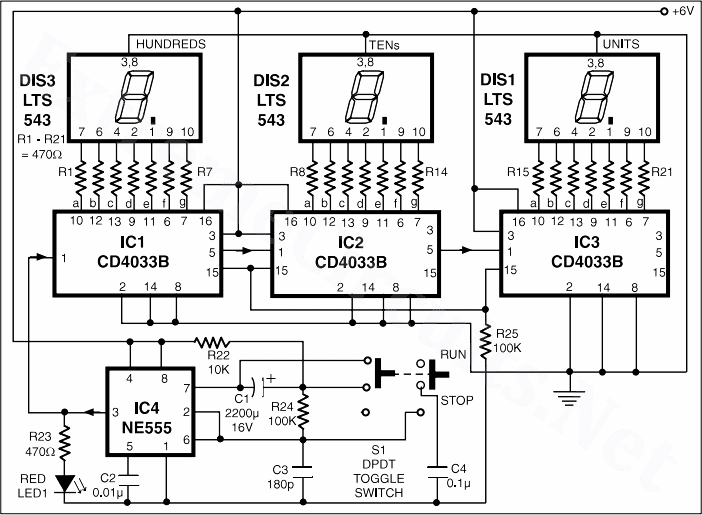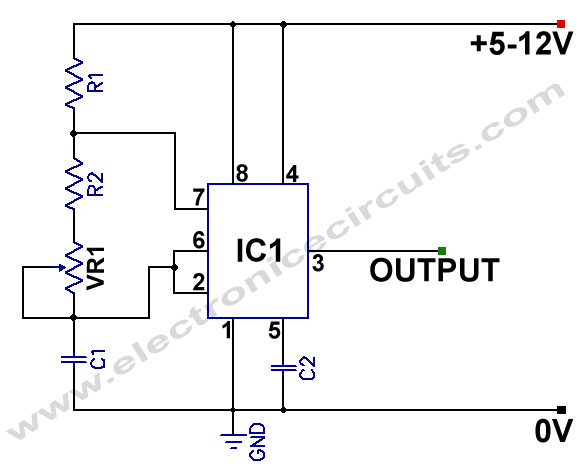
Triangle Wave Generator
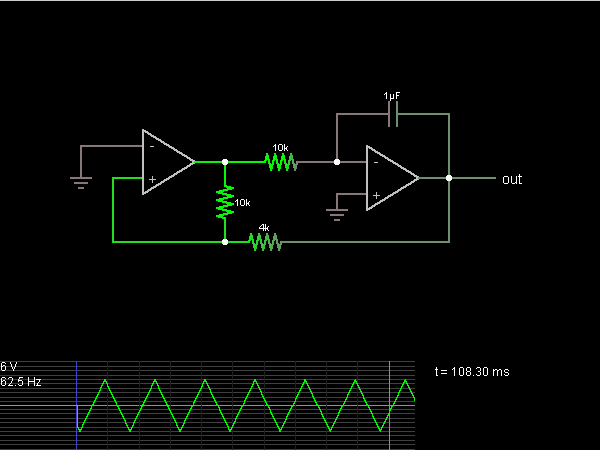
The second half of the circuit is an inverting integrator. The first operational amplifier (op-amp) begins with its two inputs in an unknown state; it can be assumed that it starts with the non-inverting input slightly higher than ground. The op-amp significantly amplifies this difference, driving its output to the maximum positive power supply voltage, which is 15 V in this case. With this positive input, the output of the integrator decreases at a constant rate. The 10k and 4k resistors function as a voltage divider, setting the non-inverting input of the first op-amp to 4/14ths of the way from the output of the second op-amp to the output of the first op-amp. When this input reaches ground, the output of the first op-amp switches polarity, causing the integrator to reverse direction, thereby forming the other half of the triangle wave. A new cycle begins when the first op-amp switches polarity again.
The described circuit primarily functions as an inverting integrator, which is a fundamental component in analog signal processing. The operational amplifier used in this configuration is critical for its ability to amplify voltage differences. Initially, the op-amp's non-inverting input is set to a voltage slightly above ground, which allows it to amplify the input difference significantly. The output voltage swings to the positive power supply limit (15 V), which indicates that the circuit is in a charging state.
The integration process is facilitated by the feedback network formed by the resistors. The 10kΩ and 4kΩ resistors create a voltage divider that stabilizes the non-inverting input of the first op-amp. This configuration ensures that the input voltage to the op-amp is carefully controlled, allowing for predictable behavior as the integrator processes the input signal.
As the output of the integrator decreases, it does so at a constant rate, which is characteristic of integration in an analog circuit. The output voltage will continue to drop until the voltage at the non-inverting input reaches ground. At this point, the op-amp's output will switch polarity, causing the integrator to reverse its output direction. This transition effectively creates a triangular waveform, as the output voltage will rise and fall in a linear fashion.
The cycle continues as the op-amp toggles between its output states, generating a continuous triangular waveform. This behavior is essential in various applications, including waveform generation and signal modulation. The precise values of the resistors can be adjusted to modify the integration rate and the frequency of the output waveform, providing flexibility in circuit design for specific applications.The second half of the circuit is an inverting integrator. The first op-amp starts with its two inputs in an unknown state; let`s say it starts with + slightly higher than (which is at ground). The op-amp greatly amplifies this difference, bringing its output to the op-amp`s positive power supply voltage, its maximum output (15 V in this case)
. With this positive input, the integrator`s output falls at a constant rate. The 10k and 4k resistors act as a voltage divider which put the first op-amp`s + input 4/14ths of the way from the second op-amp`s output to the first op-amp`s output. When this input reaches ground, then the first op-amp`s output switches polarity, and the integrator switches direction, forming the other half of the triangle.
When the first op-amp switches polarity again, a new cycle begins. 🔗 External reference
The described circuit primarily functions as an inverting integrator, which is a fundamental component in analog signal processing. The operational amplifier used in this configuration is critical for its ability to amplify voltage differences. Initially, the op-amp's non-inverting input is set to a voltage slightly above ground, which allows it to amplify the input difference significantly. The output voltage swings to the positive power supply limit (15 V), which indicates that the circuit is in a charging state.
The integration process is facilitated by the feedback network formed by the resistors. The 10kΩ and 4kΩ resistors create a voltage divider that stabilizes the non-inverting input of the first op-amp. This configuration ensures that the input voltage to the op-amp is carefully controlled, allowing for predictable behavior as the integrator processes the input signal.
As the output of the integrator decreases, it does so at a constant rate, which is characteristic of integration in an analog circuit. The output voltage will continue to drop until the voltage at the non-inverting input reaches ground. At this point, the op-amp's output will switch polarity, causing the integrator to reverse its output direction. This transition effectively creates a triangular waveform, as the output voltage will rise and fall in a linear fashion.
The cycle continues as the op-amp toggles between its output states, generating a continuous triangular waveform. This behavior is essential in various applications, including waveform generation and signal modulation. The precise values of the resistors can be adjusted to modify the integration rate and the frequency of the output waveform, providing flexibility in circuit design for specific applications.The second half of the circuit is an inverting integrator. The first op-amp starts with its two inputs in an unknown state; let`s say it starts with + slightly higher than (which is at ground). The op-amp greatly amplifies this difference, bringing its output to the op-amp`s positive power supply voltage, its maximum output (15 V in this case)
. With this positive input, the integrator`s output falls at a constant rate. The 10k and 4k resistors act as a voltage divider which put the first op-amp`s + input 4/14ths of the way from the second op-amp`s output to the first op-amp`s output. When this input reaches ground, then the first op-amp`s output switches polarity, and the integrator switches direction, forming the other half of the triangle.
When the first op-amp switches polarity again, a new cycle begins. 🔗 External reference
